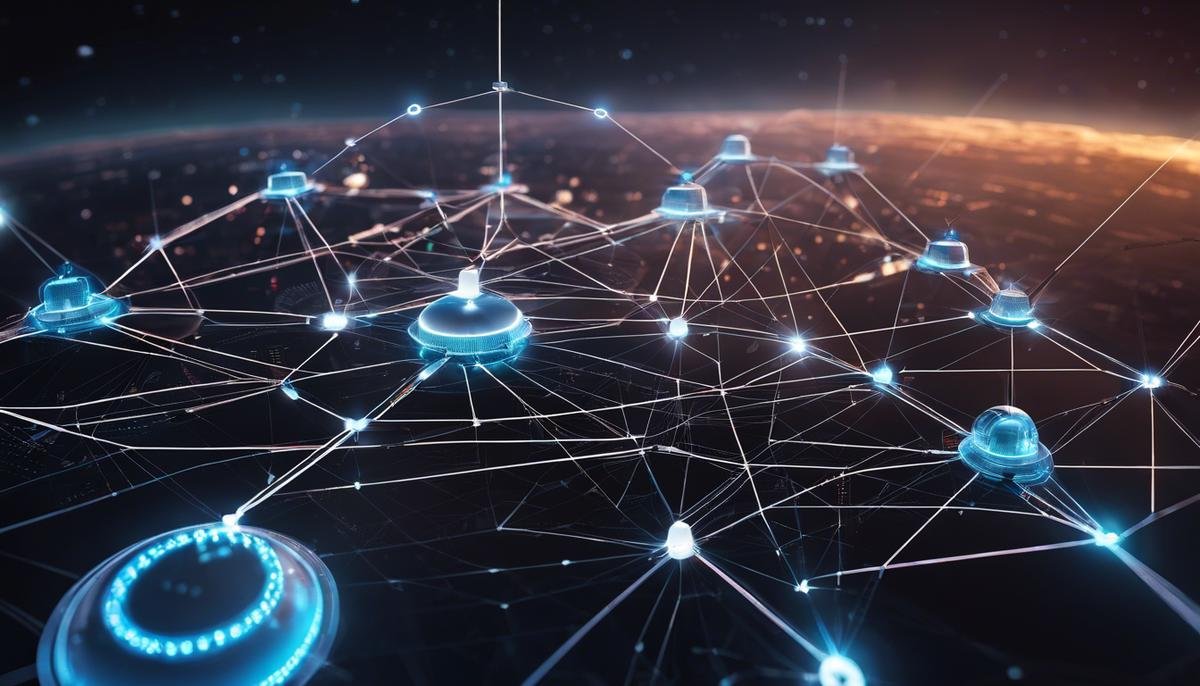In an era where the boundaries between human intelligence and artificial proficiency are becoming increasingly blurred, OpenAI’s Generative Pre-trained Transformer 3, more familiarly known as GPT-3, stands at the forefront of this transformative wave. As we embark on a journey through this intricate labyrinth of algorithms and neural networks, the sheer scale and capabilities of GPT-3 promise to redefine our understanding of machine learning and its potential to emulate human-like understanding. From analyzing its groundbreaking architecture to witnessing its astonishingly diverse applications across various industries, we uncover the remarkable ways in which GPT-3 is not just augmenting but often surpassing human efforts in complex tasks, engendering a new era of technological symbiosis.
Understanding GPT-3 and Its Capabilities
GPT-3: A Quantum Leap in Artificial Intelligence
The world of technology never stands still. For those who crave the newest, groundbreaking advancements, welcome to the era of GPT-3, the artificial intelligence revolution that is rewriting the rulebook of what machines can achieve.
What is GPT-3, you might ask? It stands for Generative Pre-trained Transformer 3, and it’s the latest iteration of AI models designed by OpenAI. With an astonishing capacity to process and generate human-like text, GPT-3 is swiftly changing the game across multiple fields.
First off, its language processing abilities are unprecedented. Equipped with 175 billion parameters – think of them like knobs and dials that the AI adjusts to better understand and generate language – GPT-3 can produce content so convincingly human, it blurs the line between man and machine. From penning essays to crafting poetry, GPT-3 can do it all, and often with just a tiny amount of input.
But why does GPT-3 matter? It’s simple: Efficiency. GPT-3 automates tasks that used to consume hours of human effort. Coding, for example, becomes a breeze. Tell GPT-3 what kind of program you want, and it can draft the code. It’s not just about doing tasks faster, it’s about unlocking new levels of productivity.
In terms of creativity, GPT-3 pushes boundaries too. Using its sophisticated understanding, it assists in designing user interfaces, automating creative writing, and even aiding in game development. The AI’s versatility in generating diverse content from minimal prompts means that it can act as a creative partner, handling mundane aspects while amplifying human creativity.
Furthermore, GPT-3 is democratizing expertise. Need a personal tutor or a legal consultant? GPT-3 can fill in the gaps, providing insights and information that were once gated behind years of study or expensive consultancy fees.
Sure, like any advanced technology, it has its Achilles’ heel.
There are concerns about bias and misinformation, but the tech community is dedicated to ensuring responsible use. As with any tool, it comes down to how we wield it.
In conclusion, GPT-3 is not just redefining the boundaries of AI – it’s expanding them. It’s transforming nearly every industry it touches and changing our perceptions about the capabilities of machines. For early adopters and tech enthusiasts, GPT-3 is no less than a glimpse into the future of AI – a future that’s already at our fingertips.

Practical Applications of GPT-3
Harnessing the Power of GPT-3 in Customer Service and Education
As the latest evolution in artificial intelligence, GPT-3’s muscle is not just for tech savants. It’s a tool for boosting efficiency across a spectrum of industries, especially where its text-generation and understanding capabilities can shine. Let’s zoom in on two sectors where GPT-3 could truly make a difference: Customer service and education.
Customer Service Revolutionized
First up, customer service. Imagine a world where waiting in long phone queues to speak with a representative is ancient history. GPT-3 ushers in this new era. With its top-notch language processing abilities, GPT-3 can power chatbots and virtual assistants, providing instant, accurate, and human-like responses to customer inquiries.
This isn’t just about answering simple questions; it’s about complex problem-solving in real-time. From tech support to order tracking, GPT-3’s potential to interpret and respond to customer needs will drastically cut down response times and increase customer satisfaction. And because customer service can make or break a business, those that leverage GPT-3 will likely sprint ahead of the competition.
A New Chapter for Education
Let’s switch gears to education, another realm ripe for a GPT-3 makeover. Educators are always looking for ways to personalize learning and give students one-on-one attention. Well, enter GPT-3, the AI that can power personalized learning tools, adaptive learning platforms, and even serve as a virtual tutor.
Consider language learning apps that can converse with students in natural language, providing corrections and encouragement. Or imagine a history program that answers students’ detailed questions about the Roman Empire or the mysteries of quantum physics. GPT-3’s ability to generate informative, accurate content can transform these scenarios from fiction to fact.
Moreover, GPT-3 can serve as a research assistant, helping both teachers and students to cut through the information overload by summarizing articles, translating languages, or even generating study guides. This can bridge educational gaps, providing high-quality assistance that was once the luxury of the few.
Not just theoretical musings, these are practical, impactful, and—more importantly—achievable advancements that GPT-3 stands ready to deliver. By implementing this AI in customer service and education, the tech can not only tailor answers and learning experiences but also scale these services to reach a broader audience. The future is now and GPT-3 is here to shape it. Forget science fiction—this is science fact, and it’s incredibly exciting.

Ethical Considerations and Challenges
Onward to the Ethical Crossroads: The Impact of GPT-3
The cutting-edge technology of GPT-3 is not only about pushing the envelope in AI; it’s about navigating uncharted waters when it comes to ethical considerations. Let’s dive into the ethical predicaments that this AI phenomenon presents.
First off, there’s the job market conundrum. With GPT-3’s knack for automation, jobs in customer service, coding, and content creation are at risk. Sure, efficiency skyrockets, but where does this leave the human workforce? The tech community must grapple with the balance between innovation and employment.
Secondly, imagine a world where AI-generated content is indistinguishable from that created by humans. The authenticity and originality of content are at stake here. Artists, writers, and designers could find their work competing with AI’s infinite creativity. Acknowledging individual expression and protecting intellectual property are puzzles we must solve.
Thirdly, there’s the matter of ‘deepfakes’. GPT-3’s realistic text generation can fabricate believable narratives, impersonate individuals, and distort reality. The repercussions? Misinformation campaigns, manipulated media, and false identities. The tech ecosystem must rally to fortify truth and accountability.
Next, ponder the implications for education. Personalized AI tutors create unmatched learning opportunities, but they also introduce questions about the quality and integrity of education. How do we ensure that AI supplements rather than replaces educators? Safeguarding the human element in learning is crucial.
Lastly, with GPT-3, we face a pressing question: Who is responsible for AI’s actions? Developers, companies, or the AI itself? Defining accountability is critical, especially as AI systems become increasingly autonomous. Fostering responsible AI development and deployment is non-negotiable.
All things considered, GPT-3 isn’t just transforming tech—it’s compelling us to confront ethical challenges head-on. Let’s rise to the occasion and sculpt a future that heralds both tech progress and ethical responsibility.

Photo by markusspiske on Unsplash
Integrating GPT-3 into Business and Services
Streamlining Operations with GPT-3: The New Frontier for Business Innovation
Businesses stand on the brink of a new era marked by artificial intelligence, with GPT-3 spearheading a revolution across sectors. To stay ahead, companies must look towards this technology not only to keep up with the trends but to redefine their operational paradigms.
Incorporating GPT-3 in Business Intelligence
The pool of data businesses generate is vast and chaotic. GPT-3 serves as the master key to unlocking actionable insights from this data. By training it on specific datasets, businesses can extract trends, forecasts, and make data-driven decisions at lightning speed. This fuels a competitive edge by enabling smarter and quicker strategies.
Enhancing Content Marketing with AI
In the content-saturated market, how do businesses stand out? Enter GPT-3. By leveraging its ability to craft compelling content, companies can automate the production of articles, advertisements, and social media posts. The trick is to refine GPT-3 with brand-specific data, thus ensuring content aligns with the brand voice and ethos while maintaining a high throughput.
Optimizing Supply Chain and Logistics
The agility of GPT-3 can be transformative in supply chain management. Predictive analytics powered by GPT-3 can forecast demand, identify potential disruptions, and suggest optimal inventory levels. Businesses can streamline logistics, reduce waste, and ensure timely delivery which, in turn, boosts customer loyalty and trust.
Revolutionizing HR and Recruitment Processes
Human Resources departments can deploy GPT-3 to automate resume screening, draft personalized emails, and even help in crafting job descriptions. This frees up HR professionals to focus on the human element – nurturing relationships and fostering a positive work culture.
Facilitating Legal and Compliance Workflows
Businesses are burdened by the need to navigate complex legal landscapes. GPT-3 can be a game changer, combing through legal documents, assisting in drafting contracts, and ensuring compliance is followed without draining time and resources.
Implementation: A Structured Approach
To integrate GPT-3, businesses must start with a strategic vision tailored to their specific needs. This includes identifying the key areas that stand to benefit the most from AI automation. Training sessions for employees and establishing robust data-governance policies are paramount to make the most of GPT-3 while mitigating risks. Collaborating with AI and machine learning experts can facilitate a smooth transition, ensuring that GPT-3 tools are leveraged responsibly and effectively.
Advancing Customer Interactions
Customer relationship systems powered by GPT-3 can provide round-the-clock service, up-to-date information, and a personalized touch, reminding customers they are valued. Businesses can implement GPT-3 chatbots and virtual assistants that interact seamlessly with customers, deftly handling inquiries with ease and precision, elevating the customer experience to new heights.
Conclusion
Forward-thinking businesses are already planting the seeds for a future where GPT-3 is integral to operations. As the technology evolves, so too does the potential for automation, efficiency, and creativity in the workplace. It is critical to consider the broader implications, including the ethical use and the possible need for new regulations as AI pervades more aspects of business. Those who embrace GPT-3 now will be the architects of a future where artificial intelligence and human ingenuity converge for unprecedented progress.

Future Directions and Evolution of GPT-3
GPT-3’s Trailblazing Path Forward: What Does the Future Hold?
As technology races ahead, GPT-3 stands tall as a true titan among artificial intelligence advancements. This pinnacle of machine learning excellence has already reshaped the landscape of natural language processing, and its influence is only poised to expand. Eyes are trained on the horizon, and one question looms large: what does the future hold for the evolution of GPT-3?
Looking beyond its current triumphs, GPT-3’s potential to refine and reshape healthcare is at the forefront. Imagine a system that can sort through medical data with superhuman efficiency, crafting perfectly tailored treatment plans or sifting through reams of research to unearth hidden connections that could lead to breakthroughs in medicine.
The sphere of personal assistants and smart home devices is another domain where GPT-3 is expected to surge ahead. Current iterations are useful, but we’re talking about an evolution to ultra-intelligent assistants that not only respond to our commands but anticipate our needs and learn our preferences, all with a nuance that blurs the line between human and machine interaction.
In the world of finance, GPT-3 has the potential to revolutionize the way we manage and predict economic trends. By harnessing its predictive capabilities and its grasp on complex data analysis, financial institutions could see a new era of efficiency and informed decision-making. Goodbye, antiquated algorithms; hello, AI-driven forecasts with unprecedented accuracy.
But, what about the ethical quandaries and the digital can of worms that GPT-3’s evolution could open? Advances in technology always come with a catch, don’t they? Mitigating the risks of misused AI-generated content, safeguarding against “deepfakes,” and constructing a robust framework for accountability will be pivotal. Developers and legislators must collaborate to ensure that the ethical deployment of GPT-3 keeps pace with its technical capabilities.
The developer community is buzzing with excitement over the idea of GPT-3 as a co-pilot in software development. Picture thousands, if not millions, of developers being catapulted to new heights of efficiency with GPT-3-based tools that catch bugs, optimize code, and even generate complex algorithms on the fly. Talk about changing the game.
In the entertainment sphere, GPT-3’s potential to generate immersive and dynamic storylines could spawn a new golden age for video games and interactive media. Expect richer narratives and characters so lifelike that gamers may forget they’re conversing with a machine.
Finally, GPT-3 is poised to become a linchpin in the Internet of Things (IoT). As devices become smarter and more interconnected, GPT-3 can serve as the glue that binds them together. But this isn’t just about turning on your coffee maker from your phone; it’s about creating a seamless machine-to-machine language that could transform industries – from managing smart cities to environmental monitoring.
In the evolving tapestry of GPT-3’s utility belts, it’s clear: automation, efficiency, and an almost precognitive grasp on human needs are on the horizon. Yes, challenges need tackling, but the overarching trajectory for GPT-3? Unabashedly upward. Stay tuned for the ride – it’s going to be extraordinary.

As we stand at the cusp of a new horizon in artificial intelligence, GPT-3 emerges as both a beacon of potential and a powerful testament to human ingenuity. It’s a harbinger of a future where AI and human expertise are intertwined so deeply that the resultant synergies could revolutionize every aspect of our lives. The evolution of GPT-3 goes on to embody our collective aspirations and concerns, encapsulating the bright prospects of AI-driven innovation while compelling us to confront and navigate the intricate moral terrains it brings forth. The journey of GPT-3 is far from over; it is an ongoing narrative of progress, challenge, and the ever-evolving partnership between humans and the intelligent machines we create.



